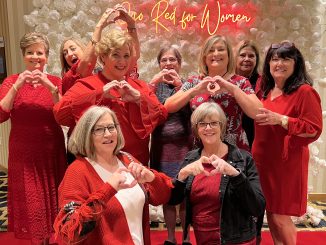
Voices of St. Charles Parish: Allison Prendergast
Dear Editor, I wanted to make local residents aware of a proposal to destroy nearly 80 acres of wetlands on the west bank of St. Charles Parish to add a 200-home subdivision in an area with no hurricane protection levee.
Willowridge Estates wants to build Phase VI of this neighborhood behind the southernmost part of Willowdale Boulevard.
They are in the process of applying for permits from the Corps of Engineers, the state Department of Natural Resources and the state Department of Environment Quality. This application is for an 83.8 acre subdivision; the Corps and DNR both have declared 78.85 acres of this as wetlands. I know this because as an adjacent land-owner, I received a copy of the joint public notice.
I think that this proposal not only impacts people in St. Charles Parish, but in fact, it impacts everyone in the state because this is inconsistent with other major public efforts to save our wetlands. And I believe it is potentially embarrassing and can sabotage our efforts to gain funding to restore our wetlands and fragile coast.
Coastal Restoration?
I cannot believe that after Hurricane Katrina – and while practically every major local, state, and federal official is saying we need to protect our wetlands – that any governmental agency would even be considering destroying nearly 80 acres of wetlands!
Last week, Senator David Vitter hosted a hearing on coastal restoration and the Louisiana Coastal Impact Assistance Program (CIAP) held its first public hearing on its plan to spend billions of federal oil & gas dollars to restore our coastland.
The Louisiana Speaks effort by the LRA includes a component on how future residential development should occur in our state, particularly in areas near the coastline. And President George Bush himself visited our area while our congressional delegation asked him for more money to restore our coasts.
These are just a few of the numerous efforts ongoing throughout our state to restore our wetlands in light of the attention and damage brought on by Hurricanes Katrina and Rita.
So in this environment, how can this project even be considered?
Project inconsistent
Protecting this area must be important to the state – and to our parish – because the CIAP has included the Lake Salvador Shoreline Protection Project Phase III as one of its selected coastal restoration projects to the tune of $2.6 million. The parish is sharing the costs on this project. Why spend this money – our tax dollars
– to protect the wetlands around Lake Salvador, yet approve the destruction of 80 acres of wetlands a few miles north of that area?
In addition, a DNR representative recommended the permit for this project be denied for several reasons, including its proximity to the federally-protected Willowridge Conservation Servitude, which was established several years ago by the EPA as mitigation for Willowridge’s destruction of wetlands and forests in Phase V.
There has already been an incident of wetlands destruction by this developer, but that was before Katrina. Surely we know better now!
Since there is no hurricane protection levee for this portion of the west bank, these 80 acres are a key component of the only hurricane protection we have. This area acts as a buffer zone for us.
In fact, the DNR field investigator stated in his report that this area acts as a storm surge buffer zone for us. Basically, this IS our hurricane protection.
And that brings me to my final point: St. Charles Parish and the Corps of Engineers’ have been working for years to put a hurricane protection levee behind Willowridge. But, according to Roger Swindler, the Corps’ levee project manager, “There is no accepted alignment at this time for the hurricane protection levee.”
The levee should be established before the subdivision, otherwise, aren’t we putting additional property at risk?
The bottom line is this: after Katrina and Rita, why would we even allow development in areas without hurricane protection – all throughout the state, not just in this neighborhood – and knowingly put more people at risk?
Isn’t this just too costly a proposition for all – in terms of personal property destruction, sky-high insurance premiums and little coverage and/or payout, millions of governmental (tax-payer) dollars to help those whose homes have been destroyed! Can we really afford this?
While I am living in an expansion portion of this neighborhood, knowing now what we do about our coasts, should this portion have even been developed?
I’m not opposed to new development in our parish; I just think we should learn from the lessons of Katrina and Rita, and be wise about where we develop.
What can you do?
If you agree that this project is wrong, I encourage you to speak up! Officials are accepting comments from the public until March 14. You can get more information about it on either the Corps of Engineers website or the DNR website.
To see just how vulnerable we are, type in your address on Google maps, click on “Hybrid” on the right side and keep zooming out. You’ll see that we’re just northwest of Lakes Cataoutche and Salvador, and they in turn are just northwest of the Barataria Basin and the Gulf of Mexico.
We must protect this area. How can the rest of the country take us seriously and allocate funds to protect our coast, if we don’t protect it ourselves?
Need more info? Want to get involved? Here’s how:
You can sound off or get more information via the Internet sites and e-mail addresses below:
The Corps of Engineers website is http://www.mvn.usace.army.mil/ – when you get there, click on Regulatory, then public notice.
You can email comments to Darrell.Barbara@mvn02.usace.army.mil … just be sure to include this number which identifies the project: MVN-2006-3898-EFF .
The DNR website is http://dnr.louisiana.gov/ .
Once there, click on the red box on right that says SONRIS.
Then click on “Inquiry” on left hand column under Coastal Use Permits.
Still with me? Good! Click on “Search coastal use permits”, type in CUP# P20060372 (the DNR # identifying this project), then click ONLINE.
Now, click “Add Comment” and you’re done. You can also view other comments once you’re done by hitting the back arrow and clicking on “View comments.”
Local residents may have their last chance this month for input on the proposed route for Interstate 49 through St. Charles.




Be the first to comment